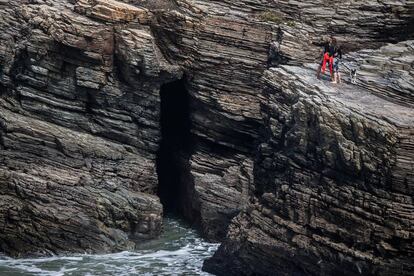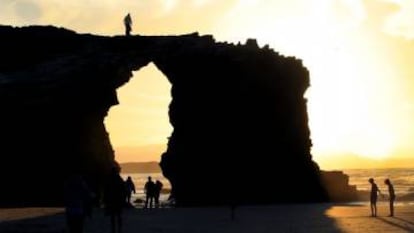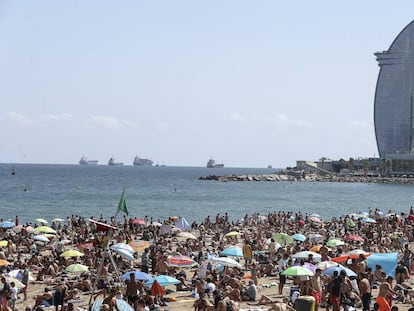A death foretold at Galicia’s coastal “Cathedral”
After a tourist was killed by a falling rock while admiring the incredible formations at As Catedrais, experts say that rising tourism could lead to further tragedy


“Every year hundreds of thousands of people visit As Catedrais,” says geologist Juan Ramón Vidal Romaní. “The fact there’s only been one fatality is incredibly lucky, but that’s not to say this won’t change.”
Vidal Romaní is speaking in the wake of the death there during Easter of a 25-year-old tourist who was killed by a falling rock while admiring the incredible formations shaped by the sea along the northern Galician coast, along with hundreds of other tourists. Just six months ago, Romaní wrote a report warning the regional government of the dangers of rock falls along the coastline in Ribadeo, in Lugo province, particularly after heavy and sustained rainfall.
“People are aggravating the wear and tear to the cliffs,” says the expert. “Some climb up to the arches for photos and jump from one ridge to another. It makes your hair stand on end.”
A 25-year-old tourist was killed by a falling rock while admiring the incredible formations shaped by the Bay of Biscay along with hundreds of other tourists
Unique in Europe, these coastal rock formations have been shaped by the waves and the wind for the past 135,000 years, but it is tourism, not the sea, that is now putting this naturally carved “cathedral” at risk.
“Visitors are the greatest threat,” says Vidal Romaní, director of the Parga Pondal Geology Institute and professor of geodynamics at the University of A Coruña. “There is a notable impact and things have got out of control.”
Vidal Romaní suggests permanent surveillance of the area, which currently curbs numbers during Easter and over the summer months, with a limit of 4,812 visitors a day. He also advises the use of protective headgear when entering the caves where the tourist was killed, and the installation of a fence around the steepest inclines.
Facing a barrage of criticism in the wake of the tragedy, the regional environment department has commissioned engineers at the University of A Coruña to analyze the current state of the cliffs. According to the authorities, only after they produce their report can effective measures be implemented to guarantee their conservation.
Alberto Núñez Feijóo’s government, which is responsible for the protected area, claims that nothing could have prevented the fatal incident and insists that tourists visiting the region in high season assume the risks involved when they get the go-ahead to go down to the beach. In response to the recommendations made in the last official report, the risks have been more widely publicized and are flagged up on the regional government’s website.

Vidal Romaní is not alone in warning against mass tourism in As Catedrais. Augusto Pérez Alberti, professor of geography at the University of Santiago, tweeted last January about the perilous nature of the site and the possibility of such a tragedy occurring. Meanwhile, the Galician Society of Natural History (SGHN), which also warned of fatal rock falls, has called for greater restrictions on visitor numbers and prohibiting access to the top of the cliffs.
“There has been abusive promotion of the area that has led to crowds that are incompatible with the conservation of the spot and the habitats of European interest there,” says Serafín González, SGHN president and a researcher at the public research agency CSIC.
The Galician government insists that environmental criteria were applied when establishing the current quota of visitors. “Right now, we have no study suggesting that the number is excessive,” says a spokesman. However, the Ribadeo Council’s Special Plan for the Protection of the Praia das Catedrais states that the constant footsteps of increasing numbers of visitors are eroding large areas of cliff, adding that the lack of visitor control means that people wander into precarious areas that could endanger their physical wellbeing and that of visitors below on the beach.
More popular than the Giant’s Causeway
In the space of 35 years As Catedrais has become a tourist magnet in the region of Mariña Lucense. Previously, the beach was known as Augas Santas, and few but those in the vicinity were aware of its beauty.
This changed, however, when Ribadeo native Leopoldo Calvo Sotelo became Spanish prime minister in 1981 and was photographed bathing there. In 2015, Ribadeo’s council estimates that, with the current controls in place, almost 700,000 people visited the landmark, 200,000 more than visited the Giant’s Causeway in Northern Ireland, an area famous for its 40,000 interlocking basalt columns caused by volcanic activity more than 60 million years ago.
People are aggravating the wear and tear to the cliffs, some climb up to the arches for photos and jump from one ridge to another. It makes your hair stand on end Juan Ramón Vidal Romaní
Prior to restrictions, a veritable avalanche of humanity would descend on the cliffs during the holidays. On Good Friday of 2014, there were more than 20,000 people at low tide when the rock formations can be fully appreciated. And in the first two weeks of July that same year, 150,000 people flocked to the location.
“The problem is that the treasure cave has been discovered and people will go in as long as they are allowed to,” says Romaní. But while the mayor of Ribadeo, Fernando Suárez Barcia, refuses to comment on the future of As Catedrais, hotel and café owners in the area are against further restrictions. “You can’t limit people’s freedom to visit a beach,” says the President of Lugo’s Hospitality Association, Cheché Real.
Real does, however, support an agreement between the regional government, the coastal authorities and the council on measures to protect the area and those who visit it, though he warns against scaremongering. “What happened at Easter was the kind of accident that could happen canyoneering or at a water park,” he says.
Geologists give As Catedrais “two centuries to live”

“Only the location is being exploited at the moment but there are a number of [geological] processes and stories that could be explained in As Catedrais that would generate more profit and provide tourist satisfaction,” says Manuel Monge, a geologist from the Urdaibai Biosphere Reserve in the Basque Country.
An expert on the history of the Cantabrian cornice, he has a different perspective on history, measuring the passage of time in thousands of years rather than centuries. He explains that the grandeur of As Catedrais resides in the fact that it is an evolving landmark, shaped by “special erosion” in which part of the cliff remains due to harder rock while other softer parts wear away.
Following the collapse of the Azure Window in Malta due to storms in 2017, an official report from the regional government gives As Catedrais between 100 and 200 years before it meets a similar fate. “I don’t share the opinion that we should stabilize the arches,” says Monge. “Nature should follow its course, creating other formations.”
But the geologist does advocate studying the landmark to isolate its weakest points and avoid unnecessary risks to visitors. He also suggests offering a guided tour explaining the whys and wherefores of this geological phenomenon. And, then there’s climate change. As Catedrais’s life span is being shortened by the increasing sea levels of two millimeters each year in Ribadeo as well as unseasonal coastal storms.
English version by Heather Galloway.
Tu suscripción se está usando en otro dispositivo
¿Quieres añadir otro usuario a tu suscripción?
Si continúas leyendo en este dispositivo, no se podrá leer en el otro.
FlechaTu suscripción se está usando en otro dispositivo y solo puedes acceder a EL PAÍS desde un dispositivo a la vez.
Si quieres compartir tu cuenta, cambia tu suscripción a la modalidad Premium, así podrás añadir otro usuario. Cada uno accederá con su propia cuenta de email, lo que os permitirá personalizar vuestra experiencia en EL PAÍS.
¿Tienes una suscripción de empresa? Accede aquí para contratar más cuentas.
En el caso de no saber quién está usando tu cuenta, te recomendamos cambiar tu contraseña aquí.
Si decides continuar compartiendo tu cuenta, este mensaje se mostrará en tu dispositivo y en el de la otra persona que está usando tu cuenta de forma indefinida, afectando a tu experiencia de lectura. Puedes consultar aquí los términos y condiciones de la suscripción digital.
More information
Archived In
Últimas noticias
Maduro pleads not guilty before the federal court in New York: ‘I am still the president of Venezuela’
A new test can detect Alzheimer’s from a finger prick
UN team enters Sudanese city of El Fasher after paramilitary massacre: ‘It’s like a ghost town’
A recipe for resistance: Indigenous peoples politicize their struggles from the kitchen
Most viewed
- Gilles Lipovetsky: ‘If you want to live better and fall in love, take Prozac, don’t look to philosophy’
- Alain Aspect, Nobel laureate in physics: ‘Einstein was so smart that he would have had to recognize quantum entanglement’
- Maduro’s downfall puts China’s relationship with Venezuela to the test
- Why oil has been at the center of Venezuela-US conflicts for decades
- Alvin Hellerstein, a 92-year-old judge appointed by Bill Clinton, to preside over Maduro’s trial in New York










































